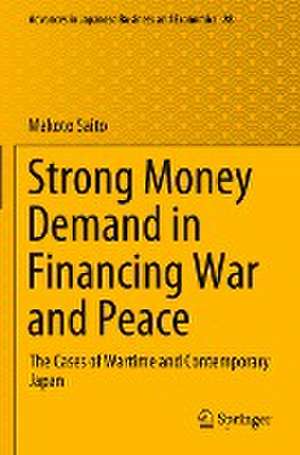Strong Money Demand in Financing War and Peace: The Cases of Wartime and Contemporary Japan: Advances in Japanese Business and Economics, cartea 28
Autor Makoto Saitoen Limba Engleză Paperback – 18 iun 2022
| Toate formatele și edițiile | Preț | Express |
|---|---|---|
| Paperback (1) | 723.56 lei 43-57 zile | |
| Springer Nature Singapore – 18 iun 2022 | 723.56 lei 43-57 zile | |
| Hardback (1) | 729.53 lei 43-57 zile | |
| Springer Nature Singapore – 17 iun 2021 | 729.53 lei 43-57 zile |
Din seria Advances in Japanese Business and Economics
- 24%
 Preț: 619.83 lei
Preț: 619.83 lei - 20%
 Preț: 557.70 lei
Preț: 557.70 lei - 24%
 Preț: 789.77 lei
Preț: 789.77 lei - 15%
 Preț: 646.30 lei
Preț: 646.30 lei -
 Preț: 390.63 lei
Preț: 390.63 lei - 18%
 Preț: 736.64 lei
Preț: 736.64 lei - 18%
 Preț: 722.88 lei
Preț: 722.88 lei - 18%
 Preț: 730.16 lei
Preț: 730.16 lei - 15%
 Preț: 644.30 lei
Preț: 644.30 lei - 15%
 Preț: 583.28 lei
Preț: 583.28 lei - 18%
 Preț: 730.65 lei
Preț: 730.65 lei - 18%
 Preț: 785.11 lei
Preț: 785.11 lei - 18%
 Preț: 731.10 lei
Preț: 731.10 lei - 15%
 Preț: 647.27 lei
Preț: 647.27 lei -
 Preț: 389.31 lei
Preț: 389.31 lei - 18%
 Preț: 887.86 lei
Preț: 887.86 lei - 24%
 Preț: 599.83 lei
Preț: 599.83 lei - 15%
 Preț: 526.83 lei
Preț: 526.83 lei - 18%
 Preț: 784.30 lei
Preț: 784.30 lei -
 Preț: 389.70 lei
Preț: 389.70 lei - 18%
 Preț: 999.60 lei
Preț: 999.60 lei - 18%
 Preț: 724.80 lei
Preț: 724.80 lei - 18%
 Preț: 724.00 lei
Preț: 724.00 lei - 18%
 Preț: 949.10 lei
Preț: 949.10 lei - 18%
 Preț: 780.52 lei
Preț: 780.52 lei - 18%
 Preț: 784.13 lei
Preț: 784.13 lei -
 Preț: 394.29 lei
Preț: 394.29 lei - 15%
 Preț: 642.18 lei
Preț: 642.18 lei - 15%
 Preț: 649.22 lei
Preț: 649.22 lei -
 Preț: 391.22 lei
Preț: 391.22 lei -
 Preț: 390.63 lei
Preț: 390.63 lei - 27%
 Preț: 517.85 lei
Preț: 517.85 lei
Preț: 723.56 lei
Preț vechi: 882.39 lei
-18% Nou
Puncte Express: 1085
Preț estimativ în valută:
138.46€ • 144.92$ • 115.24£
138.46€ • 144.92$ • 115.24£
Carte tipărită la comandă
Livrare economică 31 martie-14 aprilie
Preluare comenzi: 021 569.72.76
Specificații
ISBN-13: 9789811624483
ISBN-10: 9811624488
Ilustrații: XXIV, 204 p. 52 illus., 8 illus. in color.
Dimensiuni: 155 x 235 mm
Greutate: 0.33 kg
Ediția:1st ed. 2021
Editura: Springer Nature Singapore
Colecția Springer
Seria Advances in Japanese Business and Economics
Locul publicării:Singapore, Singapore
ISBN-10: 9811624488
Ilustrații: XXIV, 204 p. 52 illus., 8 illus. in color.
Dimensiuni: 155 x 235 mm
Greutate: 0.33 kg
Ediția:1st ed. 2021
Editura: Springer Nature Singapore
Colecția Springer
Seria Advances in Japanese Business and Economics
Locul publicării:Singapore, Singapore
Cuprins
Long-Run Observations (the 1890s to the 2010s) and an Alternative Theory of the Price Level.- Demand for BOJ Notes from Black Markets under Price Controls (1937 to 1949).- On Wartime Money Finance in the Japanese Occupied Territories (1942 to 1945)
Notă biografică
Makoto Saito is Professor at Graduate School of Economics, Nagoya University, where he has been on the faculty since 2019. He received his B.A. from Kyoto University, and his Ph.D. from Massachusetts Institute of Technology. After he worked as economist at The Sumitomo Trust Bank, he was on the faculty at The University of British Columbia, Kyoto University, Osaka University, and Hitotsubashi University. His long-run research agenda concerns dynamics of asset pricing in the presence of heterogeneous agents in both domestic and international contexts. Immediately after the Great East Japan Earthquake happened in March, 2011, he conducted intensive research into the causes, effects, and consequences of the earthquake, including the Fukushima-Daiichi nuclear power accident. His recent research puts the Bank of Japan’s monetary policy in historical contexts, and explores policy implications. He published many papers in professional journals, including Journal of Monetary Economics,Journal of International Economics, Journal of Mathematical Economics, and Review of Income and Wealth. He received Ishikawa Prize from The Japanese Economic Association in 2007, and was given Medal with Purple Ribbon from the Emperor in 2014. For his books published in Japanese, he receives Nikkei Prize for Excellent Books in Economic Science in 2002, Economist Prize in 2008, The Zengin Foundation Award in 2010, and Ishibashi Tanzan Prize in 2012.
Textul de pe ultima copertă
This book theoretically and empirically investigates the emergence of strong money demand in wartime Japan (1937–1945), its disappearance after the end of the war (1945–1949), and the reemergence of strong money demand in contemporary Japan (from 1995 to the present) in terms of the effects on fiscal activities and the price level. An augmented fiscal/monetary theory of the price level is constructed from a close examination of the strong money demand present in these periods. Then, profoundly puzzling phenomena such as mild deflation despite monetary expansion, low long-term interest rates despite fiscal unsustainability, and weak aggregate demand despite near-zero rates of interest, all of which are actually being observed in contemporary Japan, can now be interpreted in line with the above augmented theory. In the present, strong money demand at near-zero rates endows the Japanese government with maximum fiscal flexibility. However, if it disappeared for some reason, prices wouldsurge to the quantity theory of money level, and fiscal sustainability would have to be restored. In the future, alternative currency units issued by private banks might carry out a purge of such strong demand for the yen.
Caracteristici
Investigates the emergence of strong money demand in wartime Japan and its reemergence in contemporary Japan Constructs an augmented fiscal/monetary theory of price level by examining strong money demand in the above two periods Explains puzzling monetary and fiscal phenomena observed in contemporary Japan
